Beyond AI Detection: What Really Makes Content Valuable

Don’t feel bad if your content has been accused of being AI generated.
Many tools on the market claim they can spot AI-written content. Sometimes they are right, sometimes not.
Like recently when a client was working on a technical blog post - written with the help and oversight of their CTO with many years of experience. Despite the specialized knowledge that only comes from years of hands-on work, the piece was still flagged as 30% 'AI-generated.' The irony wasn't lost on us.
Every day, we see expert-written content getting falsely flagged by AI detection tools. While many tools claim they can spot AI-written content with certainty, the reality is far more complicated.
These detection systems face significant limitations and often prove unreliable, though do have instances where they work.
Detectors can struggle with accuracy, producing both false positives that wrongly flag human-written content (like the US Constitution) as AI-generated and false negatives that fail to identify actual AI-generated text.
Even OpenAI, the creator of ChatGPT, has acknowledged that detectors cannot reliably distinguish between AI and human-written content, demonstrated by their decision to discontinue their own AI Classifier tool due to poor performance.
The fundamental problem lies in the fact that these detectors rely on probabilistic analysis and statistical patterns rather than direct verification of content origin.
And as AI language models continue to evolve and improve, the challenge of reliable detection becomes increasingly complex, making it virtually impossible for current detection systems to maintain consistent accuracy.
Ultimately, the best content strategy isn't about evading AI detection – it's about creating work that's too valuable to question.
How AI Detectors Actually Work
AI detectors are sophisticated tools designed to identify text generated by artificial intelligence systems like ChatGPT by analyzing characteristics such as perplexity (unpredictability of content) and burstiness (variation in sentence structure).
Think of AI detectors like spell checkers, but instead of looking for spelling mistakes, they look for patterns in writing.
Here's what they actually do:
- They count how often certain words and phrases appear
- They look at how predictable the writing is
- They compare these patterns to what they think AI writing looks like
OpenAI notes why AI detectors simply don’t work:
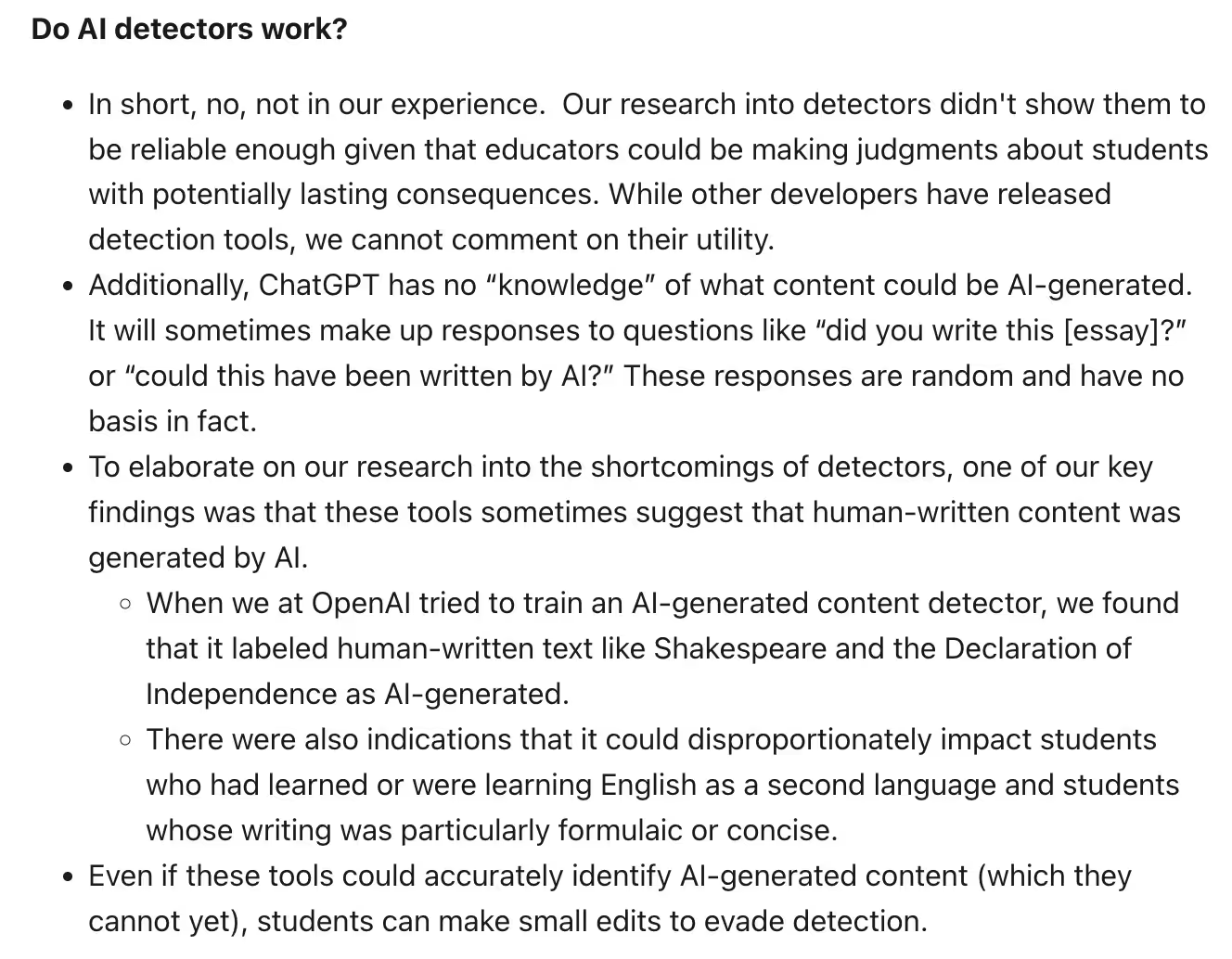
Where AI Detectors Are Important (and Work Best)
Critical sectors are actively developing specialized detection systems to meet their unique needs. In healthcare, for example, Mendel and UMass Amherst created a framework to identify hallucinations in AI-generated medical summaries, focusing on medical event inconsistencies and incorrect reasoning. The Hypercube system combines medical knowledge bases with symbolic reasoning for pre-review content verification.
While general-purpose AI detectors remain unreliable, these domain-specific efforts show promise in addressing specialized verification challenges.
This is what Google considers “Your Money or Your Life” topics, that could “significantly impact the health, financial stability, or safety of people, or the welfare or wellbeing of society”:
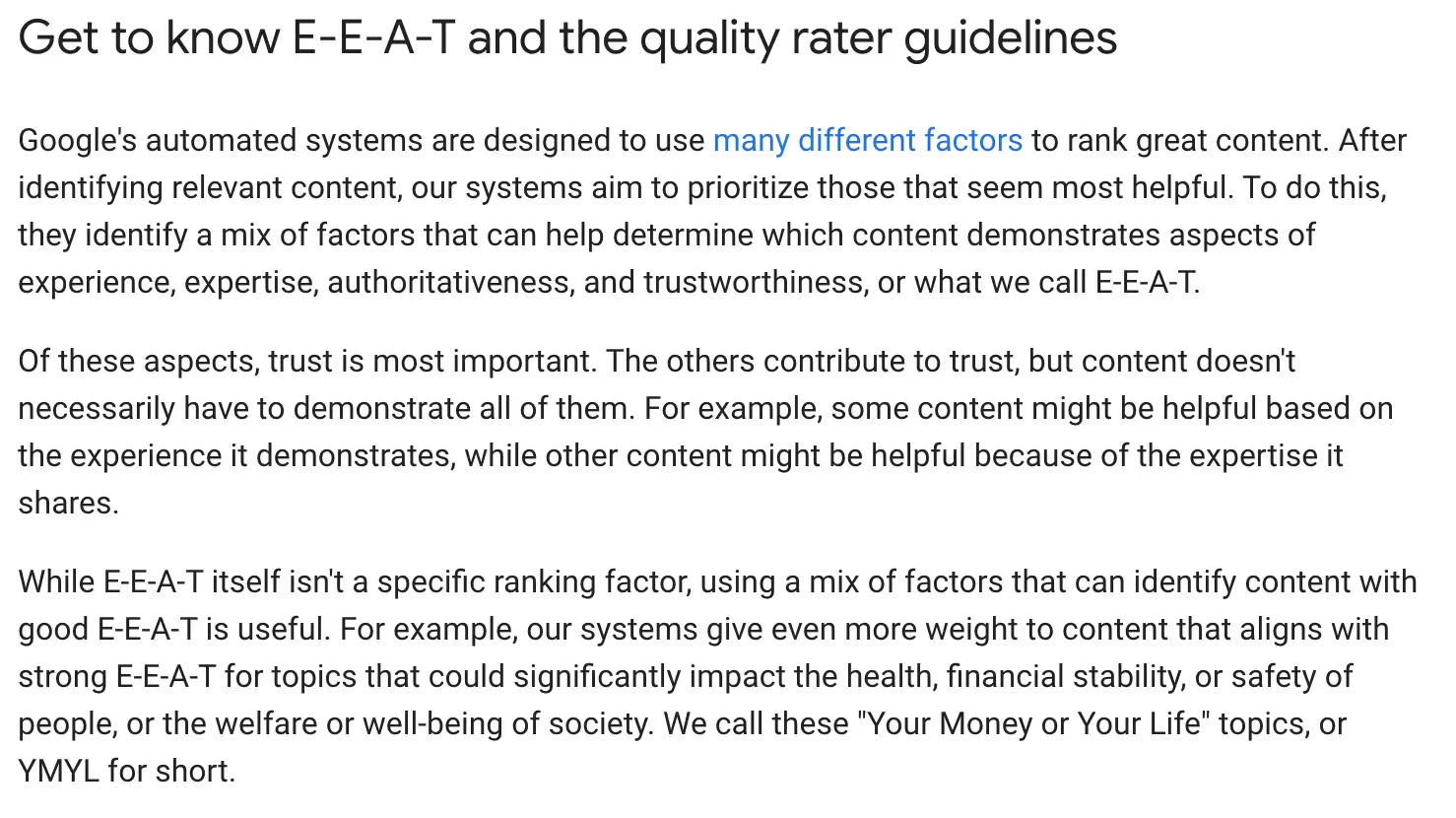
Moreover, AI detectors are helpful at identifying lazy, bulk-created content.
It is this type of content that ultimately falls under the umbrella of “spammy, low-quality content” that Google penalizes.
The Fundamental Flaws
Recent research shows that even the best AI detectors are struggling to keep up.
Academic studies have concluded that detectors are more effective at identifying content generated by GPT 3.5, and not as effective with identifying GPT 4. This "underscores the need for further development and refinement of AI content detection tools as AI-generated content becomes more sophisticated and harder to distinguish from human-written text,” the researchers write.
A viral moment in 2023 shared when an AI detector identified the US Constitution as “likely to be written entirely by AI”
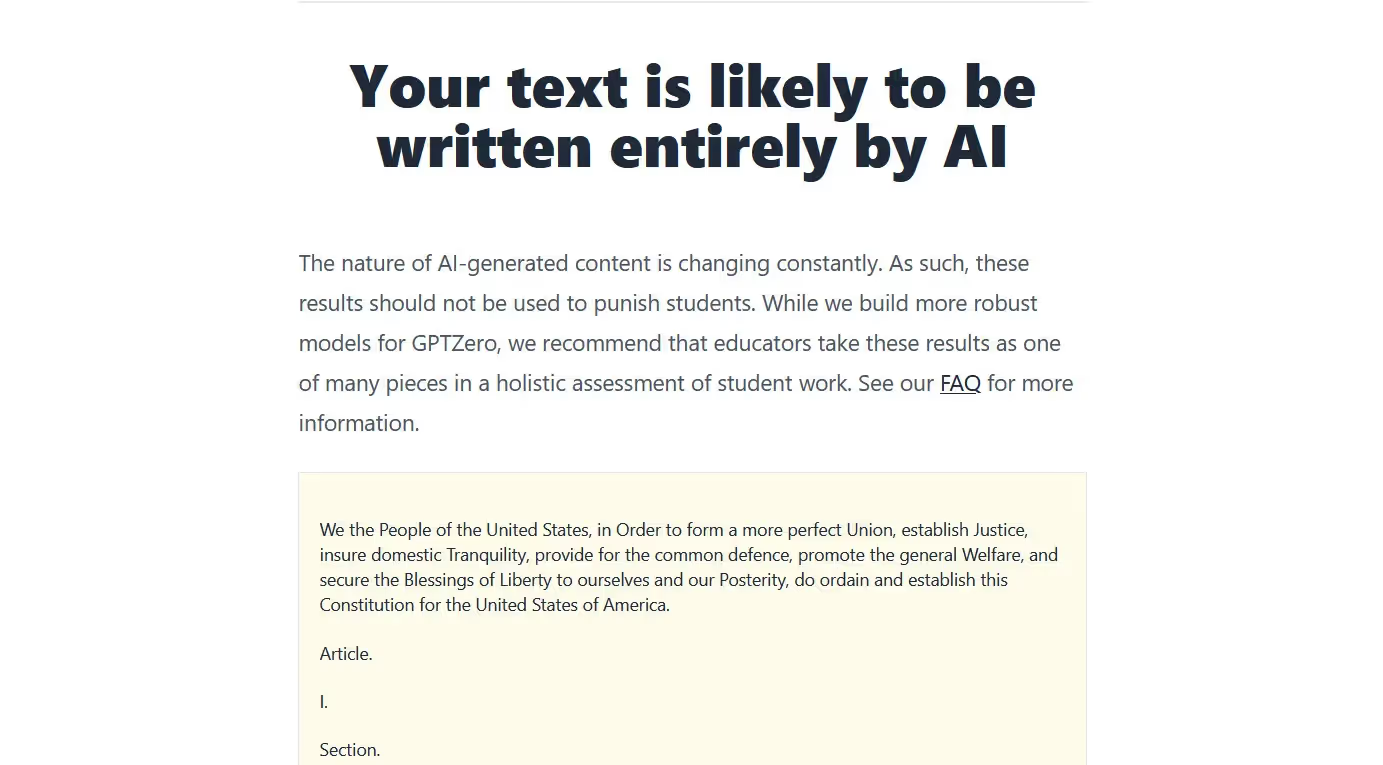
The Detection Arms Race
Across the content industry, a concerning trend has emerged: writers and marketing teams are getting caught in an endless cycle of writing, checking AI detection scores, and rewriting content until it "passes" as human-written. This approach fundamentally misunderstands what makes content valuable and wastes resources that could be better spent elsewhere.
The Hidden Cost of False Positives
The time cost of this approach is staggering. Marketing teams can spend hours reworking perfectly good content, replacing clear language with complicated alternatives, all in an attempt to fool detection tools.
This is like repainting a house repeatedly to look good in photos while ignoring structural issues that actually matter to residents.
While many worry about AI-generated content flooding the internet, recent research tells a different story.
A comprehensive study by Graphite shows purely AI-generated content makes up 3% of web pages - content that typically underperforms in search rankings.
While human-created content dominates at 51%, the highest-performing content often combines human expertise with AI assistance. This data suggests the panic over AI detection is misplaced - the focus should be on quality, not detection tools.
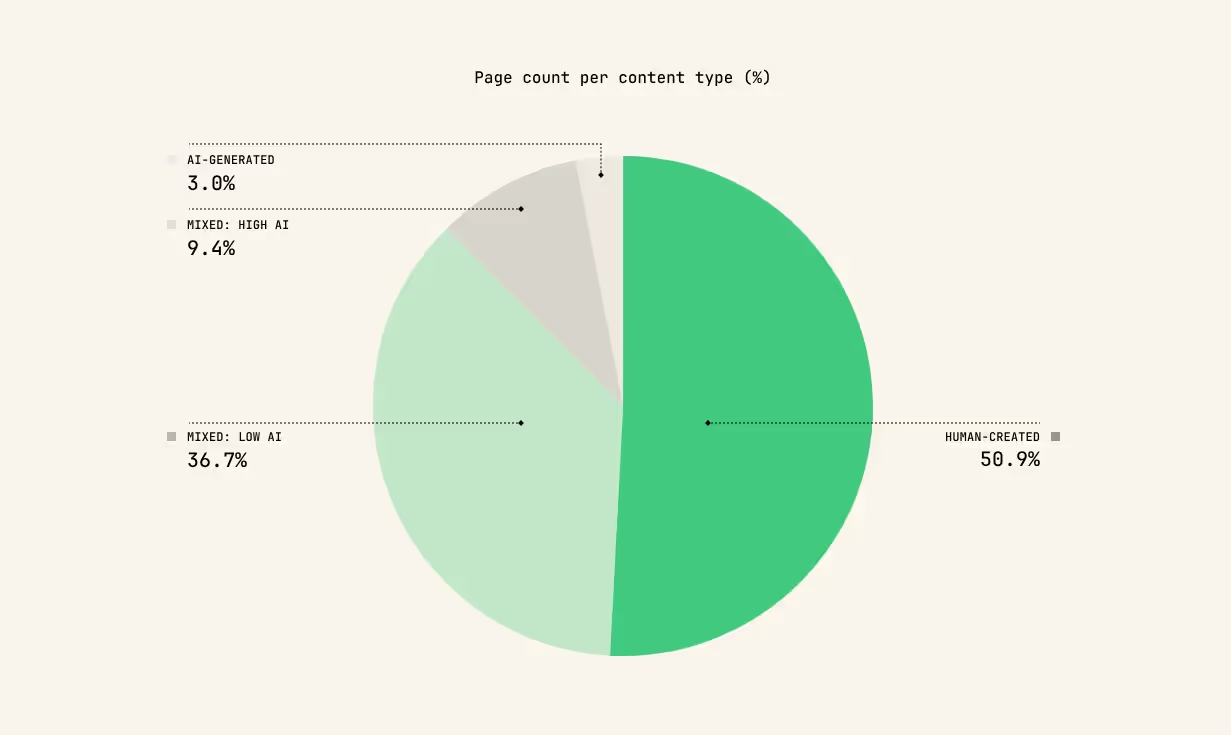
Ultimately, this obsession with passing AI detection leads to worse content, not better.
Clear industry terms get replaced because they "look too AI." Natural writing becomes convoluted to game the system. Writers second-guess their expertise, worried that sharing specialized knowledge might trigger detection flags.
This results in watered-down content that serves neither readers nor business goals.
Redirecting Energy to What Matters
Instead of obsessing over detection scores, successful content teams focus on creating genuine value.
They ask fundamental questions about their content:
- Does this content solve real problems for their audience?
- Does it share unique insights from their experience?
- Does it demonstrate expertise that their competitors can't easily replicate?
The Path Forward: Create Better Content
The solution therefore shouldn’t revolve around how to beat AI content detectors.
Instead, the focus should simply be how to create content so valuable and unique that it doesn't matter what tools say about it.
This means focusing on sharing real expertise, telling authentic stories from your experience, and providing insights that can only come from doing the actual work in your field.
Quality content stands out because it helps readers solve problems, make decisions, or understand complex topics better.
It shares specific experiences, acknowledges nuances, and offers practical guidance based on real-world application.
These qualities can't be measured by AI detection tools – they can only be judged by your audience.
What Actually Matters: The Real Quality Indicators
Here are some ways that you can evaluate your content quality, instead of running it through a content detector:
Expert Review: The Foundation of Quality
Expert review is your first and strongest line of defense against poor content.
Ideally you have industry or niche experts that evaluate your work to spot inaccuracies, identify missing context, and ensure the piece delivers real value.
These subject matter experts who add credibility to your posts – your founders, engineers, customers – should help with the nuance and expertise that conveys value.
Reader Response: The Ultimate Truth
Reader response is your most honest feedback mechanism.
When readers engage with your content in meaningful ways – sharing it with colleagues, citing it in social posts, sending backlinks – you've created something valuable.
The best content creates conversations. Readers leave thoughtful comments on your posts, ask follow-up questions, and share their own experiences. This kind of engagement shows that you're contributing something meaningful to your industry's discourse.
The Markers of Quality Content
The best content includes details that only come from real experience: specific challenges faced, unexpected solutions discovered through trial and error, proprietary data, or nuanced insights about why certain approaches work better than others. These details are impossible to fake because they come from actual work in the field.
The best content teaches readers something new while proving your expertise.
8 Ways To Create Successful Content in the AI Era
The most effective content today is premised on proprietary data, insights, and stories that are unique to your brand or product. Then leveraging AI to scale the irreplaceable elements of human expertise and experience.
- Lead with Unique Knowledge: Start with "what do we know that others don't?" instead of "what should we write about?" Share specific stories and solutions from your actual experience.
- Transform Data into Insights: Turn your company's experiences into content assets. Instead of generic guides, share real campaign data, client results, and lessons learned from failures.
- Solve Real Problems: Focus on specific challenges your audience faces, backed by concrete examples from your work. Generic advice is everywhere – your real-world solutions are unique.
- Show, Don't Tell: Include detailed examples and actual metrics. Don't just advise "improve customer service" – share the exact steps and results from your own experience.
- Build Consistent Authority: Create a body of work that demonstrates deep expertise over time through industry knowledge, case studies, and unique perspectives.
- Track Meaningful Engagement: Forget AI detection scores. Focus on reader time spent, shares, discussions generated, and business conversations sparked.
- Balance AI and Expertise: Use AI as a research assistant and first-draft writer, but let human experts add the insights, nuance, and deep understanding that make content valuable.
- Focus on Quality First: Start with expertise, add original research, ensure expert review, and confirm each piece solves a specific problem for your audience.
We covered the details of how to create AI-powered content in a recent piece, The New Rules of AI Content: Win by Being Impossible to Copy
Wrapping Up
AI detectors do have their discrete use cases to determine what content is written by AI, however after you complete a draft of your content your first editor would be a subject matter expert, and not an AI detector.
Good content proves itself through reader value and business results, not arbitrary detection scores.
Your human reviewer will tell you whether you meet this threshold, not an AI bot.
While others chase false metrics, successful companies focus on sharing real expertise that no detector could ever properly evaluate.
Ultimately, don't stress about dodging AI detection with your content - just create content so valuable it speaks for itself.
Ready to focus on what really matters?
Book a call with AirOps to learn how to scale your growth strategy with AI.
Win AI Search.
Increase brand visibility across AI search and Google with the only platform taking you from insights to action.
Get the latest on AI content & marketing
Get the latest in growth and AI workflows delivered to your inbox each week

.avif)

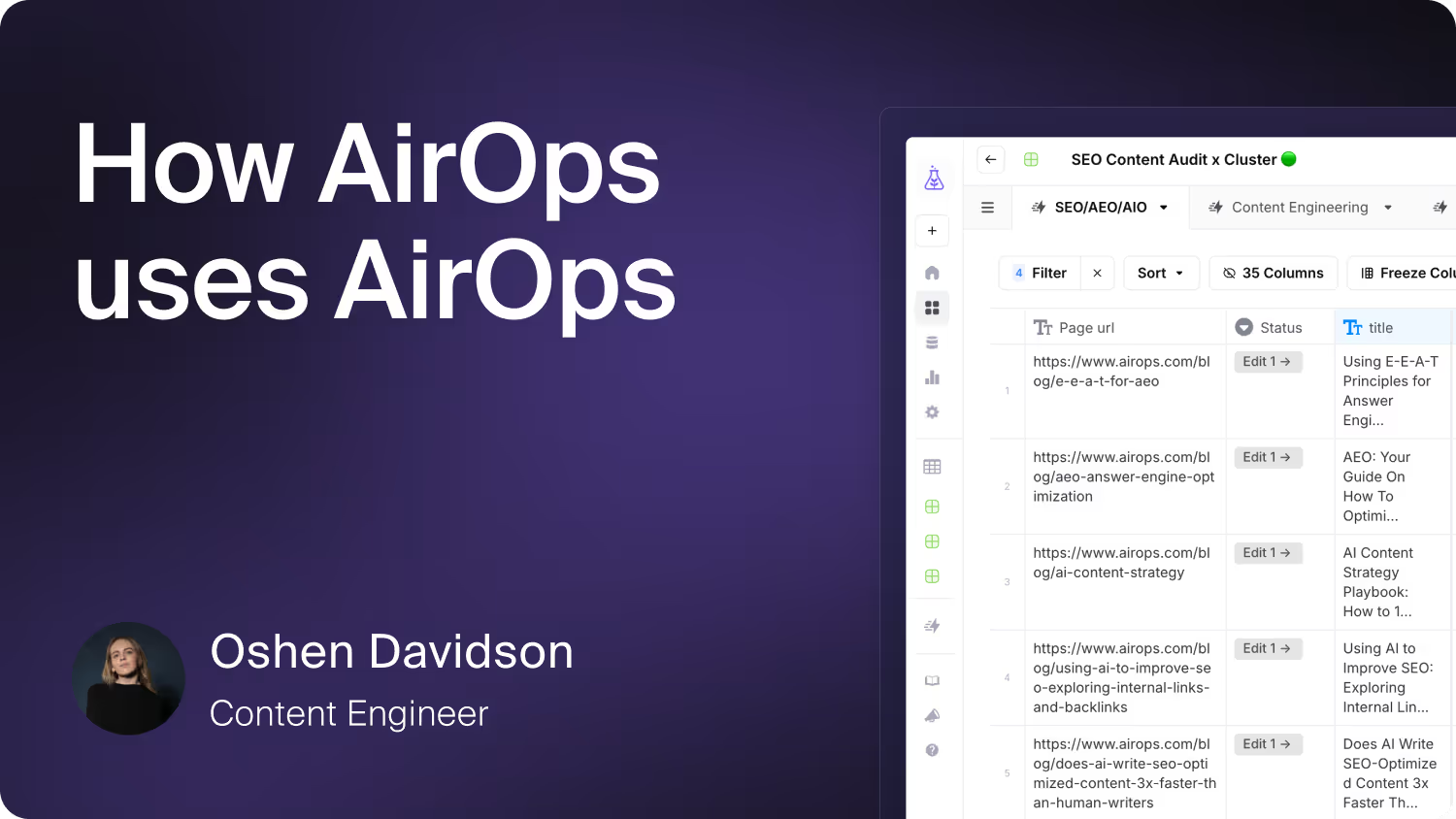

.avif)

.webp)

